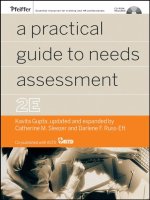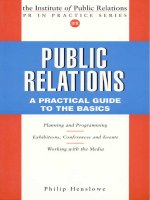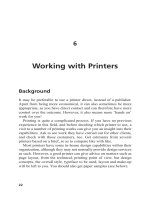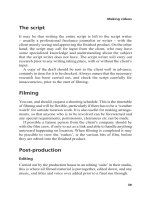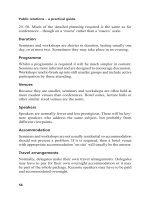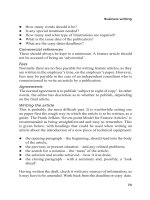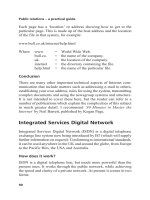Online Public Relations A Practical Guide to Developing an Online Strategy in the World of Social Media PR in Practice by David Phillips and Philip Young_1 docx
Bạn đang xem bản rút gọn của tài liệu. Xem và tải ngay bản đầy đủ của tài liệu tại đây (114.15 KB, 17 trang )
5
2
External Public
Relations Sources
Introduction
Public relations work is normally carried out either by the in-house
resource of an organization or through some form of external resource,
usually a public relations consultancy. On occasions, however, it can
be a mix of both methods. This chapter looks in outline at some of
the external resources that are available for public relations work.
Consultancies
A consultancy is not an agency, although the latter term is often used,
misleadingly, when describing a consultancy. For example, a manage-
ment consultancy is different from a management agency, in that the
former offers a whole range of consultancy services, while the latter
works on commission from employers.
Similarly, advertising agencies are agents of the media, from
whom they gain much of their income by commission on space
and air-time. They get accredited or recognized by media owners
319(02).p65 13/06/00, 12:225
Public relations – a practical guide
6
organizations (eg The National Press Agency, or the Independent
Television Contractors Association). They are a sort of commission
agent, unlike public relations consultancies, whose income comes
from fees based on expertise, experience and the number of hours
worked on a particular clients account.
Why use a consultancy?
Public relations consultancies are usually employed for the following
reasons:
l The organization concerned is not big enough, financially or other-
wise, to justify its own PR department.
l Company policy lays down that all public relations is handled
externally.
l The organization needs specialist services.
l To supply a media-relations service.
l To plan and execute a public relations programme.
l Convenience. If an organization has several offices a consultancy
can provide centrally based services for organizing functions such
as press launches, conferences and receptions.
l To handle one-off assignments.
l To provide specialist services such as house journal production,
corporate or financial public relations and parliamentary PR
sponsorship.
In the United Kingdom there are a considerable number of consult-
ancies, ranging from the very large, internationally based, to the more
modest, medium sized or very small. There are also individual PR
practitioners, some of whom offer specialized consultancy services
on a business-to-business basis, while others provide more general
coverage and a full service for their clients, directly to the public.
About 150 consultancies, who between them probably control about
three-quarters of the total UK consultancy business, are members of
the Public Relations Consultants Association (PRCA). For a consult-
ancy to become a member of the PRCA it has to comply with a set of
319(02).p65 13/06/00, 12:226
7
External public relations sources
rules covering all areas of reputable business operation. These include:
l maintaining a high level of ethical standards;
l registration of members who hold public office;
l dissemination of honest and accurate information;
l confidentiality of information obtained from clients, past and
present;
l representation of competing interests only with the consent of
those concerned;
l disclosure of any shareholding in companies whose services are
recommended to clients.
Types of consultancy
The following are the main types, or categories, of consultancy in
the UK:
The public relations department of an advertising agency
The department may be limited in scope and service due to being
constrained by the agency. Its value depends on how much and how
well the agency understands public relations and how much independ-
ence they allow the department. Sometimes its work can be no more
than publicity support for advertising but, if properly used, it can have
considerable influence on market thinking within the agency.
The public relations subsidiary of an agency
This is an independent consultancy in its own right. It has its own
clients (who may or may not be agency clients) and is responsible for
its own profitability. It has linked directors, usually one or two main
board members, and may well operate under a different name to that
of the agency.
The independent public relations consultancy
Normally, this type of consultancy has no parental ties, but may
have links with, or be part of, a larger group. It may also have a
319(02).p65 13/06/00, 12:227
Public relations – a practical guide
8
working arrangement with an advertising agency, as its clients may
need specialist services in addition to those of public relations.
Public relations consultants/counsellors
These are usually individuals who offer no more than a counselling
or consultancy service. They may be called in to give advice on a
specific area of operation, or as an external independent opinion on
internal public relations activities. Certain larger agencies and consult-
ancies may also offer this service.
Advantages of using a consultancy
Consultancies can offer independent advice through a range of serv-
ices. Thus they can criticize as well as please the client. As outsiders
they are much more objective and can often become the guardians
of the client organizations reputation. In addition they can cover many
topics with advice, both internally and externally, through trained,
qualified and experienced staff. They offer a professional service, and
they can be checked on to confirm this or otherwise!
Disadvantages of using a consultancy
Public relations concerns the internal and external communication of
an organization. A consultancy usually works to one person in the
organization the liaison officer. This can sometimes lead to a sense
of remoteness and a lack of any effective communication between
the client and the consultancy.
The client will only get what he or she pays for a number of
hours work. But because public relations is often continuous and is
integral to any organization, it may not always work office hours.
A consultancy may therefore only be able to offer a partial service,
depending on the terms of its contract.
A consultancy may not, initially at any rate, be familiar with the
culture of the client organization. Sometimes this culture plays a
319(02).p65 13/06/00, 12:228
9
External public relations sources
very important part in the work ethic of the organization and ignorance
of it can adversely affect the consultancys relationships with the client.
Mixing and matching
There are occasions when it may be more appropriate and cost
effective to use a combination of both the existing in-house resources
and a consultancy for specific tasks. This is often the case in large
organizations, where the special skills and experience of the consult-
ancy can complement those of the in-house team.
When there is only a small in-house team the use of a consultancy
for a specific project or programme is quite common and can be more
cost effective than taking on extra staff.
For further detailed information about public relations consultancies
and the role of the PRCA telephone 0171 233 6026.
319(02).p65 13/06/00, 12:229
Public relations – a practical guide
10
3
Ethics and the Law
Every society has to live by certain rules, standards and codes of
behaviour. All of us, whether in our work or in our private life, are
expected to have certain standards of behaviour and we expect those
with whom we have dealings with to have them too. In other words
we are expected, and we expect others, to behave in an ethical way.
This chapter looks at the ethical considerations of public relations
work and those aspects of the law that can, and often do, affect us. It
is meant only as a guide and not a comprehensive legal aide-mémoire.
Ethics
Ethics are defined as being those moral principles or set of moral
values held by an individual or group. Ethical conduct is defined in
the Oxford English Dictionary as being those standards that in accord-
ance with principles of conduct are considered correct, especially those
of a given profession or group.
319(03).p65 13/06/00, 12:2310
11
Ethics and the law
Codes of conduct
Every professional body, organization, profession or trade body in
the UK has its ethical standards, or codes of conduct, by which it
expects its members to abide. The Institute of Public Relations (IPR)
is no exception.
One of the main objectives of the Institute, as set out in its consti-
tution, is to establish and prescribe standards of professional and
ethical conduct and ensure the observance of such standards. The
complete IPR Code of Conduct, brought up to date in 1997 and
regularly reviewed, is contained in Appendix 1. The code clearly sets
out what is, and is not, expected of members in all their dealings.
The law
Everyone who works in public relations needs to have a basic knowl-
edge of those parts of the law that can, and often do, affect his or her
areas of work. Some detail on these aspects is given in Appendix 2.
Society has become much more litigious in recent years and defama-
tion cases are now becoming commonplace, with enormous sums of
money being awarded in settlement. Today, more than ever, there are
so many different ways in which the unwary can get caught up in
a legal wrangle or break the law unwittingly. Hence the need for
information on those parts of the law which relate to our work.
In this context it is worth remembering that when the term the
law of the land is used in documents such as agreements, contracts
and codes of conduct, it is referring to the law in England, Wales
and Northern Ireland, but not Scotland, where the law is somewhat
different.
Defamation
This concerns the publication of a statement that purports to bring
into disrepute the reputation of a person, organization or product. In
English law there are two types of defamation: Slander, the transitory
spoken word, and Libel, the written word (which includes radio
319(03).p65 13/06/00, 12:2311
Public relations – a practical guide
12
and television). It is part of civil law and can result in an action for
damages.
This is the area where the PR practitioner is most likely to be at
risk of causing offence, however innocently. The problem usually
arises from material issued to the media, or merely made public,
resulting in a civil action being brought against the practitioner, his
or her employer, or client. This can not only be damaging to the
reputation of the practitioner, employer or client, but can also be very
expensive and even, on occasions, ruinous.
Contracts
This is another area where, again, lack of even basic knowledge can
lead to litigation, industrial tribunals and civil court cases, with large
sums of money changing hands. Contracts affect almost all aspects
of public relations work, from simple letters or telephone calls to full
written, formal contracts for work or employment.
The terms of each contract will vary, but it is important to ensure
that the terms are not only implicit some are in law but are also
clearly set out so that they can be agreed by both parties.
A model form of client agreement is shown in Appendix 3.
Passing off
This is an aspect of the law which can affect practitioners and their
clients, again sometimes with damaging results. It is the misuse of a
trade name or of the trade name of goods. It also covers the imitation,
or the get-up, of the items concerned. The get-up includes the type,
size and shape of a container, the labelling and packaging of the goods
concerned. Many well-established firms such as the Kellogg Corpora-
tion, CPC International Inc. (the makers of Marmite and Bovril) have,
over many years, guarded the distinctive get-up of their products
very successfully against imitations.
Two examples of recent cases which ended in the High Court are
the action brought in 1995 by dress designer Liza Bruce against Marks
& Spencer, which produced copies of her swimwear and t-shirts, using
slightly different material and colour but at a much lower price.
319(03).p65 13/06/00, 12:2312
13
Ethics and the law
The second was the action where the Coca-Cola Corporation were
also successful in forcing the supermarket chain, Sainsburys, to
change the appearance the get-up of their own-brand cola. It was
alleged that confusion was being caused to customers wishing to
purchase Coca-Cola because of the similarity.
Details of the law affecting lotteries and competitions are contained
in Appendix 2.
Copyright law
Copyright subsists in any original work, but not in an idea. In the
United Kingdom it is subject to the Copyright, Design & Patents Act
1988 (the Act), which came into force in August 1989. There is a
great deal of detail involved and it is worth getting hold of a copy of
the synopsis. Copyright is automatic, it does not have to be applied
for, but should be declared wherever and whenever possible. Generally,
copyright covers the following areas of work:
l original literary, dramatic, musical or artistic work;
l sound recordings, films, broadcasts or cable programmes;
l typographical arrangements of published editions, including:
written or printed work;
CDs and disc records;
photographs;
pictures;
drawings and illustrations;
artwork of all descriptions;
broadcast material;
video and audio tapes;
original literary, dramatic musical or artistic works.
Qualification
The Act is limited in its effects to the UK (and colonies to which it
may be extended by Order in Council). It is primarily aimed at protect-
ing the works of British citizens.
319(03).p65 13/06/00, 12:2313
Public relations – a practical guide
14
Duration
Copyright in literary, artistic, musical or dramatic work expires 70
years after the end of the calendar year in which the author died. This
follows the implementation of an EC Directive, 93/98, effective from
1 January 1996, which extended the duration from 50 years. This
directive has had the effect of bringing back into copyright many
works which, under the Act, were no longer protected. If you are in
any doubt you should consult a lawyer with the appropriate experience.
Ownership
The general rule is that a work will be initially owned by its author,
the author being the creator of the work or, in the case of a film or
sound recording, the person who makes the arrangements necessary
for it to be made. One essential exception to this rule is that copyright
in the work of an employee produced in the course of his or her
employment will belong to his or her employer, except by any agree-
ment to the contrary.
Assignment of copyright
Ownership of copyright is to prevent exploitation of the work. How-
ever, the rights to the work can be sold with the owner retaining no
interest in it, apart from perhaps royalties. This is called an Assignment
of Rights (see Appendix 3).
Alternatively, the owner may grant a licence to another to exploit
the work, whilst retaining ownership.
Any agreements dealing with copyright must be quite clear as to
whether an assignment of rights or a licence is being granted. Any
assignment must be in writing. It can be in the form of a letter and
must be signed by, or on behalf of, the assignor. Licences can either
be in writing or granted orally. However, an exclusive licence must
be in writing.
Moral rights
A new departure from the previous work is the issue of moral rights.
This gives the author or director of the work the right to be identified
319(03).p65 13/06/00, 12:2314
15
Ethics and the law
as such in a number of different situations, mainly when the work is
being published, performed or otherwise commercially exploited.
Permission to copy
Under the Act, permission must always be obtained for the reproduc-
tion and/or use of any copyright written work which comprises any
of the following:
l an extract of more than 400 words in length;
l a series of extracts that total more than 800 words;
l a series of extracts where a single extract is more than 300 words;
l an extract, or series of extracts, that comprise more than one-
quarter of the whole work.
Provided that permission is sought, it may be that in certain circum-
stances the publishers and authors will not press for a fee or refuse to
give permission. Nonetheless, permission should always be sought,
if only as a matter of courtesy. It may also save legal and publishing
problems later.
Fair dealing
This is the exception, to permission to copy, and applies where the
material used is not a substantial part of the original work, or its use
is educational, or if it is not to be used commercially or for profit.
Under these circumstances only due acknowledgement is required,
as being both desirable and courteous.
Credits
Giving credit in some sort of form of acknowledgement is a polite
and wise thing to do. This is usually done in a list at the beginning, in
the preface, or sometimes at the end of the publication. It applies
equally to books and publications and to video and film material.
If any part of your work looks as though it might involve you in any
sort of legal problems, or if you are in any doubt check with a lawyer.
319(03).p65 13/06/00, 12:2315
Public relations – a practical guide
16
4
Working with Suppliers
Suppliers of goods and services come in all shapes and sizes, and
include photographers, designers and graphic artists, exhibition con-
tractors, video production firms, venue and conference organizers, to
mention just a few. They are vital to our work, but to get the best out
of them one or two ground rules need to be observed. A guide to
dealing with them is given in this chapter.
The brief
When using suppliers or contractors of any sort it is important that
you know and understand exactly what you expect from them and
that they understand what they are expected to produce for you. Briefs
should always be:
l written;
l comprehensive;
l clear and concise.
A brief should tell the contractor/supplier exactly what you want them
to supply or do. It will be the main point of reference between you
319(04).p65 13/06/00, 12:2516
17
Working with suppliers
and your supplier/contractor. The detail of the brief will also usually
form the principal part of any contract (see below).
Verbal briefs can be used, but if you do this it is best to subsequently
confirm the brief in writing. This way there will be less chance of
misunderstanding and subsequent errors and omissions. Often, a verbal
briefing given at the same time as a written one will save time and
unnecessary questions.
The contract or agreement
When drawing up any contract, or agreement:
l Keep it as simple as possible.
l Make sure it says what you want it to say.
l Avoid legal or any other sort of jargon wherever possible.
A contract or agreement should be specific in its wording not vague,
nor open to possible misunderstanding, nor to being misconstrued,
neither should it be open ended (see Appendix 3). Remember to check
for any financial regulations you may have in your organization (eg
work costing over a certain amount automatically going out to tender).
It is good practice to get any contract or agreement checked out by
your legal department.
Timetabling
It may be that there are deadlines that have to be worked to by your
supplier, such as production of published material in time for a launch.
If so, you should make quite sure that he or she understands what
these are and that the timetabling for publication is included in any
agreement. Penalty clauses can be incorporated if necessary.
Always allow for emergencies. If, for example, you are preparing
publication of a book for launching on a certain date, try to build
some leeway, or extra time, into your overall publication timetable.
This allows for any emergencies, such as the printers telling you that
319(04).p65 13/06/00, 12:2517
Public relations – a practical guide
18
their machines have gone down at the critical moment, or for any
distribution problems.
Costings
Costings should be as accurate and as detailed as you can get them. If
you are working within an overall budget figure then you will have
to cut your coat to suit the cloth. If you can, have a contingency
fund to allow for any sudden last-minute changes of plan or cost
increases beyond your control.
VAT
Dont forget VAT which, if not allowed for, can have a devastating
effect on your budget. If you can claim it back, all well and good, but
check for any exemptions that may apply. It may be worth getting
hold of a copy of Cronors Guide to VAT Regulations if you are in
doubt. It could save you a lot of money in the long run.
Progress chasing
Pressure may have to be kept on the contractor/supplier to ensure
that the agreed timetable is adhered to. Regular meetings to check on
progress are important because, if there are problems, the timetable
may have to be revised. Overruns may involve him in penalty clauses.
319(04).p65 13/06/00, 12:2518
19
Working with publishers
5
Working with Publishers
If you are involved in publishing work it may be to your advantage
to use a publisher rather than simply a printer. A publisher will take
care of the production, distribution and promotion of written work
and have the contacts and experience which you may not have. If
you decide to use a publisher, first make sure that you select one that
works in your field. Some are very specific and will only handle
particular types of books. For easy reference, the current edition of
the Writers and Artists Yearbook can be very helpful.
The brief
Having submitted your manuscript to a publisher, and having had it
accepted, ensure you agree the brief. This can be done verbally at a
meeting, but should always be confirmed in writing as soon as possible
thereafter, to prevent any subsequent misunderstanding. The brief can
be very specific. It can include, for example, the number and type of
illustrations, the typeface, even the page layout. Or it can be general
and non-specific, leaving the detail to the publisher.
319(05).p65 13/06/00, 12:2619
Public relations – a practical guide
20
The contract
This can either be in the form of a formal letter or, if it is complicated,
a contract. But again, the outcome should be stated quite clearly. Make
sure that any distribution and promotion details are clearly and
unequivocally stated. Any assignment of copyright, or licence to
rights, should also be included.
Get the contract, or the letter, checked first by a legal person,
preferably one who is familiar with the law of copyright.
The manuscript
Normally the submitted manuscript should be typed on single sides
of A4, in double spacing. These days the text is often submitted on
computer floppy disc together with a printed or hard copy.
However, there may be other special requirements to be met, which
may be quite detailed. The publisher will usually tell you what they
are in written guidelines.
Proofs and illustrations
You will be sent a first proof of the text of your publication from the
publisher. Proofs should always be read very carefully, to check for
errors and omissions. This may involve using a professional proof-
reader, if the publication is a technical one. Alternatively, you can
read the proofs yourself. This is also the time to make essential, last-
minute alterations to the text. You may also, at this stage, need to
consider the index.
Having done this, you will then get a final proof, showing the page
layout, position of any illustrations, the index and details such as the
cover design.
Illustrations
You should consider any illustrations you want when preparing the
text, as well as where you want them placed. They can either be spread
319(05).p65 13/06/00, 12:2620
21
Working with publishers
throughout the text or grouped together in the middle of the
publication. All pictures should be clearly captioned. When reading
the proofs, ensure that any illustrations you select are not printed back
to front, particularly photographs! Always check with the publishers
first regarding illustrations they may have special requirements.
Colour photographs are best reproduced from colour transparencies.
Colour prints do not usually reproduce well in black and white they
tend to look slightly blurred, as though shot in soft focus. If in any
doubt, talk to a professional photographer first.
Artwork
If you are using artwork (ie graphics, charts, drawings line drawings,
cartoons or any original illustrations) it must be camera ready (see
page 36). Normally, finished drawings or paintings are acceptable,
but cartoons and sketches must be in ink, with perhaps an optional
wash background.
When checking final page proofs, always check that the colours of
any artwork are as you wanted them.
Promotion and distribution
A publishers responsibilities normally include both promotion and
distribution of the publication in question. Its specific responsibilities
for these areas should be clearly stated in any agreement letter or
contract.
Depending on the terms of the agreement, the publisher will
normally take either a percentage of the unit sale price or a fixed sum
per sale.
Distribution may be local, regional or national, depending on your
requirements and the publishers capabilities. For items of regional
interest it is usually best to use a local publisher with regional
knowledge and distribution networks. For national distribution use a
publishing firm with national contacts.
319(05).p65 13/06/00, 12:2621

